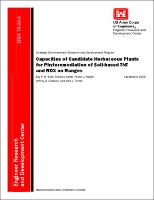Please use this identifier to cite or link to this item:
https://hdl.handle.net/11681/8582Full metadata record
| DC Field | Value | Language |
|---|---|---|
| dc.contributor | University of Illinois at Urbana-Champaign | - |
| dc.contributor | Construction Engineering Research Laboratory (U.S.) | - |
| dc.contributor | Strategic Environmental Research and Development Program (U.S.) | - |
| dc.contributor.author | Best, E. P. H. | - |
| dc.contributor.author | Smith, Thomas S. | - |
| dc.contributor.author | Hagen, Frank L. | - |
| dc.contributor.author | Dawson, Jeffrey O. | - |
| dc.contributor.author | Torrey, Alan J. | - |
| dc.date.accessioned | 2016-06-20T13:27:54Z | - |
| dc.date.available | 2016-06-20T13:27:54Z | - |
| dc.date.issued | 2008-09 | - |
| dc.identifier.uri | http://hdl.handle.net/11681/8582 | - |
| dc.description | Technical Report | - |
| dc.description | Abstract: This report describes a study to quantify the phytoextraction and phytostabilization capacities of TNT and RDX from spiked soil in selected herbaceous species, while paying attention to storage and quality of breakdown products in vegetative plant parts. Ten plant species were included in the experiments. Dose-response experiments formed the basis for evaluating the uptake and tentative in-plant degradation of the soil-based energetics and biomass characteristics of the plants. In these experiments, plants were exposed for periods ranging from 55 to 83 days in the greenhouse, biomass and evapotranspiration characteristics were determined, and residues of explosives’ parent compounds and metabolites were analyzed using HPLC techniques. Of the ten plant species tested, two grasses and four forbs were classified as TNT-tolerant. Total TNT loss from soil by processes other than plant TNT uptake ranged from 18.4 to 33.2 kg TNT ha⁻¹ in grasses and forbs, respectively. Plant TNT uptake ranged from 0.2 kg ha⁻¹ in grasses to close to none in forbs. Four grasses took up and metabolized TNT, and one forb showed some potential for TNT uptake and metabolism. All plant species were classified as RDX-tolerant. Total RDX loss from soil by processes other than plant RDX uptake ranged from 8.2 to 437 kg RDX ha⁻¹ in grasses and forbs, respectively. Plant RDX uptake ranged from 3.4 kg ha⁻¹ in grasses to 6.4 kg ha⁻¹ in forbs. Four grasses and one forb metabolized RDX. Two plant species were recommended for further exploration of their phytoextraction/plant-assisted phytoremediation capacity, both species of the uptaker/degrader type. Three other species were recommended for further exploration of their phytostabilization/plant-assisted phytoremediation capacity. | - |
| dc.publisher | Environmental Laboratory (U.S.) | - |
| dc.publisher | Engineer Research and Development Center (U.S.) | - |
| dc.relation | http://acwc.sdp.sirsi.net/client/en_US/search/asset/1002757 | - |
| dc.relation.ispartofseries | ERDC TR ; 08-8. | - |
| dc.rights | Approved for public release; distribution is unlimited. | - |
| dc.source | This Digital Resource was created in Microsoft Word and Adobe Acrobat | - |
| dc.subject | Forb | - |
| dc.subject | Grass | - |
| dc.subject | Herbaceous plants | - |
| dc.subject | Vegetation | - |
| dc.subject | Phytoremediation capacity | - |
| dc.subject | Soil-based energetics | - |
| dc.subject | Soil pollution | - |
| dc.subject | Explosives | - |
| dc.subject | Munitions | - |
| dc.subject | TNT | - |
| dc.subject | RDX | - |
| dc.subject | Training ranges | - |
| dc.subject | Firing ranges | - |
| dc.subject | Military installations | - |
| dc.title | Capacities of candidate herbaceous plants for phytoremediation of soil-based TNT and RDX on ranges | - |
| dc.type | Report | en_US |
| Appears in Collections: | Technical Report | |
